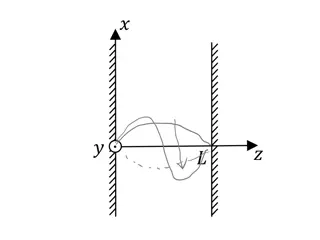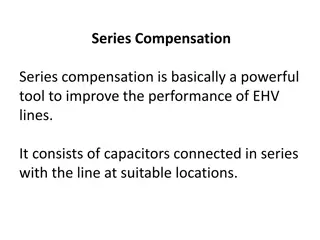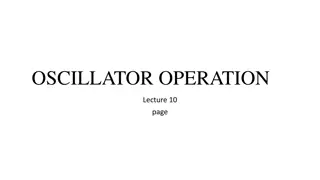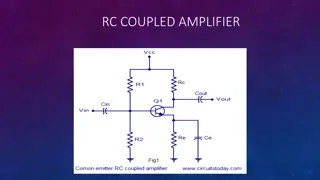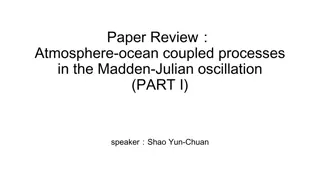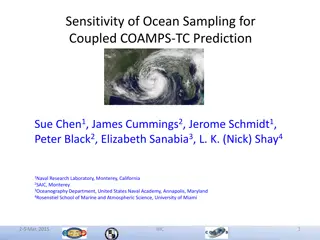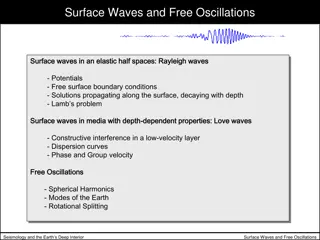
Understanding Coupled Pendulum Oscillations
Dive into the world of coupled pendulum oscillations, exploring the dynamics of two identical pendulums connected by a spring. Learn about the forces at play, equations of motion, and the effects of coupling on each pendulum's motion.
Download Presentation

Please find below an Image/Link to download the presentation.
The content on the website is provided AS IS for your information and personal use only. It may not be sold, licensed, or shared on other websites without obtaining consent from the author. If you encounter any issues during the download, it is possible that the publisher has removed the file from their server.
You are allowed to download the files provided on this website for personal or commercial use, subject to the condition that they are used lawfully. All files are the property of their respective owners.
The content on the website is provided AS IS for your information and personal use only. It may not be sold, licensed, or shared on other websites without obtaining consent from the author.
E N D
Presentation Transcript
Coupled Oscillations 10THSEPTEMBER 2019 1
Two coupled pendulums Consider a system of two identical simple pendulums, each of mass m and length l, coupled by a linear spring of force constant s. The natural length of the spring is equal to the separation of the masses at zero displacement. Let x and y be the displacements of the masses at an instant of time t. The spring is stretched or compressed depending on whether x > y or y > x. When y = x, the sprint is neither stretched nor compressed. 2
Two coupled pendulums (contd.) Generally, there are two forces acting on each pendulum: 1. gravitational force (mg) acting to each mass in the downward Fspring Fspring direction 2. spring force (F) acting to each mass mg mg in the opposite direction y x 3
Gravitational force only = I 2 = sin mgl ml l In case of small oscillation, g l y l my = = , + 0 2 0 2 0 + = = ; ; ; 0 m y g l mg Similarly, the equation of motion for 2 0 + = the other mass is 0 mx m x 4
Spring force (+gravitational force) In addition to the gravitational force, the force due to the spring connected to the masses has to be considered. However, if the spring is neither compressed nor stretched, no spring force involves in the analysis. The spring is intact. This spring introduces additional forces on the two masses when it is either stretched or compressed. If y > x, the spring is compressed. If y < x, the spring is stretched. 5
If the spring is compressed: Assume that the spring obeys the Hooke s law, the equation of motions become ( ( ) ) 2 0 2 0 = my m y s y x = + mx m x s y x Fspring Fspring mg mg y x y>x 6
If the spring is stretched: Assume that the spring obeys the Hooke s law, the equation of motions become ( ( ) ) 2 0 2 0 = + my m y s x y = mx m x s x y Fspring Fspring mg mg y x y<x 7
Two coupled pendulums (contd.) 2 0 = g l Given that the natural vibration frequency of each pendulum is given by . Finally, the equations of motion of the two pendulums, for small oscillations in a plane, are 2 0 x x m s ( ) = x y s m ( ) 2 0 = + y y x y In order to find out the effect of coupling on each pendulum, these equations must be solved for x and y. 8
The Decoupling Method Note that each DE in the previous slide contains two variables (x and y). To overcome the interaction between variables, the decoupling method is used. This is a quick and easy but can only be used in symmetric systems,.e.g. characteristics of pendulums are the same. Firstly try adding the equations of motion and interpret the result in terms of a new variable. Secondly try subtracting the equations of motion and interpret the result in terms of a new variable. 9
What happens when trying to add and subtract the equations of motion? Adding the equation of motion Subtracting the equation of motion ( 0 x y = s m ) ( ) 2 2 x y x y ( ) 2 0 + = = = + x y x + + y = = Set Therefore, Y x y Set Therefore, X x y Y x y X x y s m 2 0 2 0 = + = 2 Y Y X X Note : The two new variable describes two fundament motion of the oscillating system. 10
Normal Coordinates and Normal Modes The addition and subtraction of equations of motion, e.g. X = x + y and Y = x y make the equations of motion to contain only one dependent variable. The equations of motion become simple harmonic in terms of X and Y as follows, 2 0 + = 0 X X ( ) 2 0 + + = 2 0 Y s m Y X and Y are called normal coordinates and they associate with simple harmonic equations. As a result, each harmonic oscillator has its own way of vibration or normal mode. 11
What does the relative motion of X look like ? 2 0 + = 0 X X The equation of motion actually describes the SHM with a single natural frequency equal to (g/l)1/2. Note that the term of spring force is absent in the equation of motion. The spring is neither compressed nor stretched. https://www2.physics.ox.ac.uk/sites/default/files/2012-09-04/normalmodes_iandii_pdf_96820.pdf 12
What does the relative motion of Y look like? ( ) 2 0 + + = 2 0 Y s m Y The equation of motion actually describes the SHM with a single natural frequency equal to (g/l + 2s/m )1/2. Note that the term of spring force is present in the equation of motion. The spring is either compressed or stretched. https://www2.physics.ox.ac.uk/sites/default/files/2012-09-04/normalmodes_iandii_pdf_96820.pdf 13
Normal mode frequencies ( ) 2 0 + + = 2 0 Y s m Y 2 0 + = 0 X X The out of phase mode of vibration (x = -y) The normal mode frequency is given by The two pendulums are oscillating harmonically at this frequency. The sprig affects the motion and the coupling is effective. The in phase mode of vibration ( x = y) The normal mode frequency is given by which is the same as that of either pendulum oscillating in isolation. The effect of spring is absent. ( ) 1 2 2 0 + 2s m 0 http://physics-animations.com/Physics/English/link_txt.htm 14
The matrix method of finding normal modes Starting the method by guessing the normal modes frequency of the coupled pendulums. Recall the original equations of motion of the system ( ( ) ) ( ( ) ) + + + = = 0 mx mg x l s x y 0 my mg y l s x y Assuming that the pendulums start from the rest and the solutions of the differential equations may be written as i t = x Ae A and B are displacement amplitudes of x and y. i t = y Be 15
The matrix method of finding normal modes (contd.) Substituting the expected solution into the equations of motion and giving 2 0 2 s = = , g l s m Therefore, ( ) 2 2 0 2 s + + A B = 0 A A ( ) 2 2 0 2 s + A B = 0 B B This can be arranged in the form of eigenvalue equation with 2 as an eigen value and column vector with components A and B as eigen vector. 2 0 2 s 2 s + A B A B 2 = 2 s 2 0 2 s + 16
The matrix method of finding normal modes (contd.) 2 0 2 s 2 2 s + = A B Rearrange the previous eigenvalue equation as, 0 2 s 2 0 2 s 2 + These equations have a non-zero solution if and only if the determinant of the matrix vanishes; that is, if ( 0 ) 2 2 2 s 2 4 s + = 0 There are two solutions which are composed of 2 1 2 2 2 0 2 0 = 2 s = + 2 These give the amplitude ratios A/B = 1 for in phase mode and A/B = -1 for out of phase mode, respectively. 17
What are the amplitude ratios A/B? Referring to the eigen value equation, 2 0 + 2 s 2 2 s = A B 0 2 s 2 0 2 s 2 s 2 + A B = The amplitude ratio A/B can be determined from 2 0 2 s 2 + 2 2 1 2 0 = = The ratio A/B = 1 for in phase mode when 2 2 2 2 0 2 s The ratio A/B = -1 for out of phase mode when = = + 2 https://www2.physics.ox.ac.uk/sites/default/files/2012-09-04/normalmodes_iandii_pdf_96820.pdf 18
Problem : Find normal mode frequencies and amplitude ratio using matrix method The spring constant for all springs are s. S S S m1 = 2M; m2 = M x2 > x1 Determine normal mode frequencies https://www2.physics.ox.ac.uk/sites/default/files/lecture3_4_pdf_20475.pdf 19
Solution ( s x ) = = + = = + 2 m x sx s x x sx sx 1 1 1 2 1 x 1 2 The equations of motion for each mass : ( ) 2 m x sx sx sx 2 2 2 2 1 1 2 Because m1 = 2M; m2 = M, the above equations may be written as s s M = + x x x 1 1 2 2 s M s M 2 M = x x x 2 1 2 By giving solutions = = cos ; cos x A t x A t 1 1 2 2 20
Solution (contd.) The eigenvalue equation is given as s s M 2 A A 0 0 2 s M 1 = 2 M s 2 2 M The normal mode frequencies are + 3 3 2 1 2 0 = 2 3 3 s 2 2 2 0 2 0 = = ; 2 M Determine the ratios of the amplitudes for each normal mode frequencies! 21
Revisit the coupled oscillators S So S m m http://www.met.reading.ac.uk/pplato2/h-flap/phys5_3.html A system of two coupled oscillators of equal masses on a smooth horizontal surface is revisited. Two springs connected to the rigid wall are identical and different from the one in the middle. If the displacements of left and right masses are given as x1 and x2, respectively, the equation motion is given as : 1 1 m x sx s m x sx = + ( ) = x x 0 s 1 x 2 x ( ) 2 2 0 1 2 22
Finding the normal mode frequency by the decoupling method By combining and subtracting the equations of motion, two equations of simple harmonic motion in which each equation contains only one dependent variable (normal coordinate) is obtained. ( ) ( ) ( ) ( ) 1 2 1 2 m x x s x x = = + = Two normal modes (described by X and Y) oscillate with two different frequencies ; i.e. + = + m x x s x x 1 2 1 2 ( ) 2 s x x 0 1 2 ; X x x Y x x Given that 1 2 1 2 + + = 0 mX sX ( ) ( ) + = 2 0 mY s s Y + 2 s s s m 0 0 = = = , 1 0 2 m 23
Normal mode coordinates : X and Y General solutions for equations of motion describing the normal modes may be written as ( ( 0 2 cos Y Y t = ) = + cos X X t + 0 1 1 ) 2 Where X0, Y0, 1, 2 are constants and can be determined by the four initial conditions ( ) ( ) ( ) ( ) 0 , 0 , 0 , 0 . X X Y Y The corresponding solutions for the original coordinates x1 and x2 are given by ( ) ( 1 0 2 2 1 1 2 2 1 1 ) ( ) ( ) = + = + + + cos cos x X Y X t Y t 1 1 0 2 2 ( ) ( ) ( ) ( ) = = + + cos cos x X Y X t Y t 2 0 1 1 0 2 2 24
Normal modes (contd.) Each of the two modes is identified as the lowest mode (with a frequency of 1) and the highest mode (with a frequency of 2) . A single normal mode can be excited if the initial condition such that either X(t) =0 or Y(t) =0 for all t is made. What to be considered include (1) To excite only the lowest mode (Y(t) =0 for all t) (2) To excite the highest mode (X(t) =0 for all t) (3) To excite a linear combination of normal modes 25
Lowest normal mode excitation ( ) ( ) 0 0, 0 0 Y Y = = ( ) ( ) ( ) ( 2 0 0 sin Y Y = Let which are valid for Y0 = 0 for any 2 This gives 0 = = cos 0 Y Y 0 2 ) = 0 2 This suggests that Y(t) = 0 all the times and x1(t) = x2(t) all the times, also. Example : Choose initial conditions ( ) ( ) 1 2 cos X t a t = ( ) 0 ( ) 0 ( ) ( ) = = = = 2 , a X 0, 0 X Y t Y t As a result, . ( ( ) ) = = cos x a t The displacements of the two masses become 1 1 In phase cos x a t 2 1 26
Oscillating displacement of the lowest normal mode ( ( ) ) = = cos x a t 1 1 cos x a t 2 1 http://www.met.reading.ac.uk/pplato2/h-flap/phys5_3.html 27
Highest normal mode excitation ( ) 0 ( ) 0 ( ) ( ) 0 = = = Let 0, 0 X X X X ( ) 1 sin = 0 cos 0 This gives = which are valid for X0 = 0. 0 ( ) 1 = 0 X X 1 0 This suggests that X(t) = 0 all the times and x1(t) = -x2(t) all the times, also. Example : Choose initial conditions Y ( ) ( ) 2 2 cos Y t a t = ( ) 0 ( ) 0 ( ) ( ) = = = = 2 , a Y 0, 0 X t X t As a result, . ( ) = = cos x a t The displacements of the two masses become 1 2 Out of phase ( ) cos x a t 2 2 28
Oscillating displacement of the highest normal mode ( ) = = cos x a t 1 2 ( ) cos x a t 2 2 http://www.met.reading.ac.uk/pplato2/h-flap/phys5_3.html 29
Linear combination of normal modes excitation Given that one of the masses is displaced, so that the system is not in a normal mode. ( ) ( ) 1 1 0 , 0 x a x = ( ) 0 ( ) 0 = = = 0, 0, 0. x x The initial conditions are 2 2 ( ) 0 ( ) 0 ( ) 0 ( ) 0 = = = = This translates to , 0, , 0. X a X Y a Y This gives the expressions of the normal coordinates as follows, ( ) ( ) ( ) ) = = cos X t a t 1 ( cos Y t a t 2 30
Linear combination of normal modes excitation (contd.) Therefore, the displacement of each mass can be written as 1 cos cos 2 1 cos cos 2 ( ) ( ) ( ) = + x a t a t 1 1 2 ( ) ( ) ( ) = x a t a t 2 1 2 Or + 2 1 2 1 = cos cos x a t t 1 2 2 + Amplitude terms 2 1 2 1 = sin sin x a t t 2 2 2 http://www.met.reading.ac.uk/pplato2/h-flap/phys5_3.html 31
Energy exchange After release (t > 0), there is an energy exchange between the two masses. In short, the x2 displacement mass acquires all the energy of the x1 displacement mass which is stationary when x2 is vibrating with amplitude a but the energy is then returned to the mass originally displaced. The important point to recognize is that although individual masses may exchange energy, there is no energy exchange between the normal modes. 32
Coupled oscillations of a loaded string n = a number of masses yr = displacement of rth mass a = an equal distance between masses equilibrium Assumptions 1. Masses only move in the vertical direction. 2. The displacements from the equilibrium positions are small. 3. The gravitational force is ignored. 33
Coupled oscillations of a loaded string (contd.) T ma ( ) = + 2 y y y y Equation of motion of the rth mass is given as If, in a normal mode of oscillation of frequency , the time variation of yr is simple harmonic about the equilibrium, the displacement of rth is i t r r y = + 1 1 r r r r A e ;Ar = maximum displacement By substituting the solution for each term into the equation of motion, the relation so called fundamental equation is written as 2 2 r r A A T ma + = 0 A + 1 1 r This equation is used to determined which is the frequency of the normal mode. 34
Problem : determine the normal mode frequency using the fundamental equation In order to determine the normal mode frequency, boundary conditions at both fixed ends have be considered. They are 0 and y A y = = = = 0 A + + 0 0 1 1 n n First, when n = 1, one mass on a string of length 2a. Only one equation is needed to solve for the normal mode frequency. 2T ma The normal mode frequency is found to be . Second, when n = 2, two equations are set to solve for two normal mode frequencies which are . What are the ratios of the amplitude? and 3 T ma T ma 35
Normal vibrations of one and two masses (a) Normal vibration of a single mass m on string of length 2a (b) Normal vibration of two masses on a string length 3a Note that the number of normal modes of vibration equals the number of masses. 36
Normal modes of oscillation of n coupled masses on the string Recall the fundamental equation, 2 ma + = 2 0 A A A + 1 1 r r r T The equation can be rewritten as 2 0 2 + 2 A A T ma 2 0 + 1 1 r r = = where 2 0 A r The equation suggests that, for any particular fixed value of the normal mode frequency (say j) , the right-hand side of the equation is constant independent of r. WE HAVE TO FIND Ar THAT SATISFIES THE REQUIRMENT AND BOUNDARY CONDITIONS. 37
Normal modes of oscillation of n coupled masses on the string (Contd.) Let s assume that the amplitude of the particle r is expressed in the form = r sin r A C By substituting this guess into the rearranged fundamental equation, the left-hand side of the equation becomes A A A + + 1 1 r r = 2cos r = r sin r A C This indicates that the assumed expression complies with the requirement which is constant and independent of r. 38
Normal modes of oscillation of n coupled masses on the string (Contd.) To find an appropriate , the boundary conditions A0 = An+1 = 0 have to be considered. For the first boundary condition, A0 = 0 , as r = 0. This clearly states that the first boundary condition is automatically satisfied. For the second boundary condition, An+1 = 0 , to be satisfied, (n+1) is an integral multiple of , i.e. ( ) 1 for 1,2,3, n j j + = = j j n + = r = sin 0 r A C n As a result = = ) for 1 1,2,3, n ( + rj n = sin A C This gives the amplitude of r th mass as r 1 39
Normal modes of oscillation of n coupled masses on the string (Contd.) The allowed value of normal mode frequency j is determined by 2 0 1 1 2 r r A A A = 2 + + j + = = = 2cos 2cos j 2 0 1 n r + j 2 j 2 0 2 1 cos 1 n ? Where j may take the values j= 1, 2, , n and 2= ?0 ?? 40



